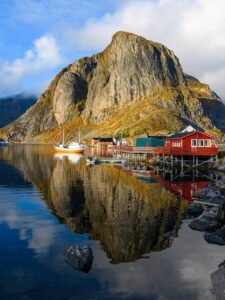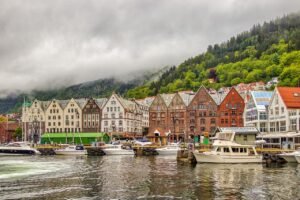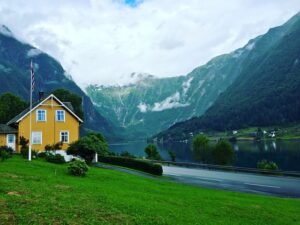

Weather and Seasons: A Norwegian Vocabulary Guide
Norway, located in Northern Europe, is known for its stunning natural landscapes and diverse climate. The country’s geography, with its long coastline, fjords, mountains, and plateaus, greatly influences its weather patterns. Norway experiences four distinct seasons: spring, summer, autumn, and winter. Each season brings its own unique weather conditions and activities.
Spring in Norway typically begins in March and lasts until May. During this time, the days start to get longer and the temperatures gradually rise. However, spring weather in Norway can be quite unpredictable, with a mix of sunny days, rain showers, and even snowfall in some areas. It is a transitional season where nature comes alive with blooming flowers and budding trees.
Summer in Norway is a much-anticipated season for locals and tourists alike. It usually starts in June and lasts until August. The days are long, with the phenomenon known as the midnight sun occurring in the northern parts of the country. Temperatures can vary across different regions of Norway, but it generally ranges from mild to warm. Summer is the perfect time to explore Norway’s breathtaking landscapes, go hiking, or enjoy outdoor activities such as fishing or kayaking.
Autumn in Norway begins in September and lasts until November. This season is characterized by cooler temperatures and shorter days. The foliage turns vibrant shades of red, orange, and yellow, making it a picturesque time to visit Norway. Autumn weather can be quite changeable, with rain showers and occasional storms. It is also the season when locals start preparing for winter by harvesting crops and gathering firewood.
Winter in Norway is a magical time when the country transforms into a winter wonderland. It typically starts in December and lasts until February. Winter weather in Norway varies greatly depending on the region. Coastal areas experience milder temperatures due to the influence of the Gulf Stream, while inland areas can be much colder. Snowfall is common, especially in the mountainous regions, making it a popular destination for winter sports enthusiasts. The days are short, with limited daylight hours, but the nights offer a chance to witness the mesmerizing Northern Lights.
Table of Contents
ToggleKey Takeaways
- Norway experiences four distinct seasons: winter, spring, summer, and autumn.
- Common weather vocabulary in Norwegian includes “vær” (weather), “regn” (rain), and “sol” (sun).
- To describe temperature in Norwegian, you can use “varm” (warm), “kald” (cold), or “mild” (mild).
- Vocabulary for precipitation in Norwegian includes “snø” (snow), “hagl” (hail), and “sludd” (sleet).
- Norwegian words for different types of clouds include “cumulus,” “stratus,” and “cirrus.”
- Vocabulary for wind and air pressure in Norwegian includes “vind” (wind) and “lufttrykk” (air pressure).
- Seasonal changes in Norwegian weather include longer days and warmer temperatures in the summer, and shorter days and colder temperatures in the winter.
- Norwegian vocabulary for winter sports and activities includes “ski” (skiing), “skøyter” (ice skating), and “snøscooter” (snowmobile).
- Celebrating seasonal holidays in Norway includes “jul” (Christmas) and “påske” (Easter).
- Understanding weather forecasts in Norwegian requires knowledge of common weather vocabulary and phrases such as “skyet” (cloudy) and “nedbør” (precipitation).
Common weather vocabulary in Norwegian
When it comes to talking about the weather in Norwegian, there are some basic phrases and common adjectives that can come in handy. Here are a few examples:
– Hva slags vær er det i dag? (What kind of weather is it today?)
– Det er solfylt. (It is sunny.)
– Det er overskyet. (It is cloudy.)
– Det regner. (It is raining.)
– Det snør. (It is snowing.)
– Det blåser. (It is windy.)
– Det er varmt. (It is hot.)
– Det er kaldt. (It is cold.)
These phrases can be used to describe the current weather conditions or to ask about the weather forecast. It’s always useful to know a few basic weather phrases when traveling or living in Norway.
Describing temperature in Norwegian
In Norway, temperature is measured in Celsius (C) rather than Fahrenheit (F). Here are some vocabulary words and phrases related to temperature:
– Grader Celsius (Degrees Celsius)
– Hvor mange grader er det? (How many degrees is it?)
– Det er 20 grader varmt/kaldt. (It is 20 degrees hot/cold.)
– Det er under null grader. (It is below zero degrees.)
Norwegians are accustomed to cold temperatures, especially during the winter months. It’s not uncommon for temperatures to drop below freezing, particularly in the northern parts of the country. On the other hand, summer temperatures can reach highs of 25 to 30 degrees Celsius, providing pleasant and warm weather for outdoor activities.
Vocabulary for precipitation in Norwegian
| Vocabulary for Precipitation in Norwegian | English Translation |
|---|---|
| Nedbør | Precipitation |
| Regn | Rain |
| Snø | Snow |
| Hagl | Hail |
| Sludd | Sleet |
| Isregn | Freezing rain |
| Tåke | Fog |
Norway is known for its abundant rainfall, particularly along the western coast. Here are some words and phrases related to precipitation:
– Regn (Rain)
– Snø (Snow)
– Sludd (Sleet)
– Hagl (Hail)
– Det regner mye/lite. (It is raining a lot/a little.)
– Det snør mye/lite. (It is snowing a lot/a little.)
– Det er sludd/hagl. (It is sleeting/hailing.)
Norwegians are well-prepared for rainy weather, with waterproof clothing and umbrellas being essential items. Snowfall is also common during the winter months, especially in the mountainous regions. It’s important to be aware of the current precipitation conditions when planning outdoor activities or traveling in Norway.
Norwegian words for different types of clouds
Clouds can provide valuable information about upcoming weather patterns. Here are some vocabulary words for identifying different types of clouds:
– Cumulus (Cumulus clouds)
– Stratus (Stratus clouds)
– Cirrus (Cirrus clouds)
– Nimbus (Nimbus clouds)
Cumulus clouds are fluffy and often associated with fair weather, while stratus clouds are low and can bring overcast conditions. Cirrus clouds are high and wispy, indicating good weather, while nimbus clouds are dark and can bring rain or snow.
Vocabulary for wind and air pressure in Norwegian

Wind plays a significant role in Norway’s weather patterns, particularly along the coastlines and in mountainous areas. Here are some words and phrases related to wind:
– Vind (Wind)
– Stille (Calm)
– Breeze (Breeze)
– Storm (Storm)
– Nordlig vind (North wind)
– Sørlig vind (South wind)
– Østlig vind (East wind)
– Vestlig vind (West wind)
Air pressure is another important factor in determining weather conditions. Here are some words and phrases related to air pressure:
– Lufttrykk (Air pressure)
– Høytrykk (High pressure)
– Lavtrykk (Low pressure)
– Stigende trykk (Rising pressure)
– Synkende trykk (Falling pressure)
Understanding wind direction and air pressure can help predict weather changes and plan outdoor activities accordingly.
Seasonal changes in Norwegian weather
Norway’s weather patterns change throughout the year, with each season bringing its own unique conditions. Here is an overview of how the weather changes from season to season:
Spring: As winter transitions into spring, temperatures gradually rise, and the days become longer. However, spring weather in Norway can be quite unpredictable, with a mix of sunny days, rain showers, and even snowfall in some areas. It is a time of renewal, with nature coming alive with blooming flowers and budding trees.
Summer: Summer in Norway is a much-anticipated season, with long days and mild to warm temperatures. The phenomenon known as the midnight sun occurs in the northern parts of the country, where the sun remains visible throughout the night. Summer is the perfect time to explore Norway’s stunning landscapes, go hiking, or enjoy outdoor activities such as fishing or kayaking.
Autumn: Autumn in Norway is characterized by cooler temperatures and shorter days. The foliage turns vibrant shades of red, orange, and yellow, making it a picturesque time to visit Norway. Autumn weather can be quite changeable, with rain showers and occasional storms. It is also the season when locals start preparing for winter by harvesting crops and gathering firewood.
Winter: Winter in Norway is a magical time when the country transforms into a winter wonderland. Snowfall is common, especially in the mountainous regions, making it a popular destination for winter sports enthusiasts. The days are short, with limited daylight hours, but the nights offer a chance to witness the mesmerizing Northern Lights. Coastal areas experience milder temperatures due to the influence of the Gulf Stream, while inland areas can be much colder.
The Gulf Stream, a warm ocean current that originates in the Gulf of Mexico, greatly influences Norway’s climate. It brings warm water and air to the coastal areas, moderating the temperatures and preventing extreme cold. This is why Norway’s coastal regions experience milder winters compared to other countries at similar latitudes. The Gulf Stream also contributes to the abundant rainfall along the western coast of Norway.
Norwegian vocabulary for winter sports and activities
Norway is a paradise for winter sports enthusiasts, offering a wide range of activities such as skiing, snowboarding, ice skating, and sledding. Here are some words and phrases related to winter sports and activities:
– Ski (Ski)
– Snowboard (Snowboard)
– Skøyter (Ice skates)
– Akebrett (Sled)
– Alpinanlegg (Ski resort)
– Langrenn (Cross-country skiing)
– Snøscooter (Snowmobile)
– Isfiske (Ice fishing)
Norway’s snowy landscapes provide the perfect backdrop for these winter activities, attracting locals and tourists alike.
Celebrating seasonal holidays in Norway
Norway has a rich tradition of celebrating seasonal holidays throughout the year. These holidays often have deep cultural and historical significance and are influenced by the country’s climate and natural surroundings. Here are some traditional Norwegian holidays and celebrations:
– Jul (Christmas): Christmas is one of the most important holidays in Norway. It is celebrated with family gatherings, festive meals, and the exchange of gifts. The weather during Christmas time is typically cold, with snowfall in many parts of the country.
– Påske (Easter): Easter is another significant holiday in Norway. It is a time when Norwegians take a break and head to the mountains for skiing and other winter activities. Easter weather can vary, with some areas still covered in snow while others experience milder temperatures.
– St. Hansaften (Midsummer’s Eve): Midsummer’s Eve, also known as St. Hansaften, is celebrated on June 23rd. It marks the beginning of summer and is often celebrated with bonfires, music, and dancing. The weather during this time is usually mild and pleasant.
– Syttende Mai (Constitution Day): Syttende Mai, or Constitution Day, is Norway’s national day celebrated on May 17th. It commemorates the signing of the Norwegian Constitution in 1814. The weather during this time can vary, but it is often a festive day filled with parades, traditional costumes, and outdoor activities.
Weather can have an impact on these holiday traditions, particularly for outdoor celebrations and activities. It’s always a good idea to check the weather forecast when planning to participate in these events.
Understanding weather forecasts in Norwegian
Weather forecasts are essential for planning outdoor activities and staying prepared for changing weather conditions. Here are some common weather forecast terms and symbols in Norwegian:
– Værvarsel (Weather forecast)
– Sol (Sun)
– Skyet (Cloudy)
– Regn (Rain)
– Snø (Snow)
– Vind (Wind)
– Temperatur (Temperature)
– Symboler (Symbols)
Weather forecast symbols are often used to represent different weather conditions. For example, a sun symbol represents sunny weather, while a cloud symbol indicates cloudy conditions. Rain and snow symbols are used to represent precipitation.
When interpreting a weather forecast in Norwegian, it’s important to pay attention to the temperature, precipitation, wind speed, and any warnings or alerts that may be mentioned. This information can help you plan your activities and dress appropriately for the weather.
In conclusion, understanding Norwegian weather and seasons is essential for anyone living in or visiting Norway. The country’s diverse climate and stunning landscapes offer a wide range of weather conditions and outdoor activities throughout the year. By learning common weather vocabulary and understanding how weather patterns change with the seasons, you can make the most of your time in Norway and be prepared for any weather conditions that come your way.
If you want to learn Norwegian, you can register for classes here. We look forward to hearing from you and helping you become fluent in Norwegian!
If you want to learn Norwegian, you can register for classes here. We look forward to hearing from you and helping you become fluent in Norwegian.





